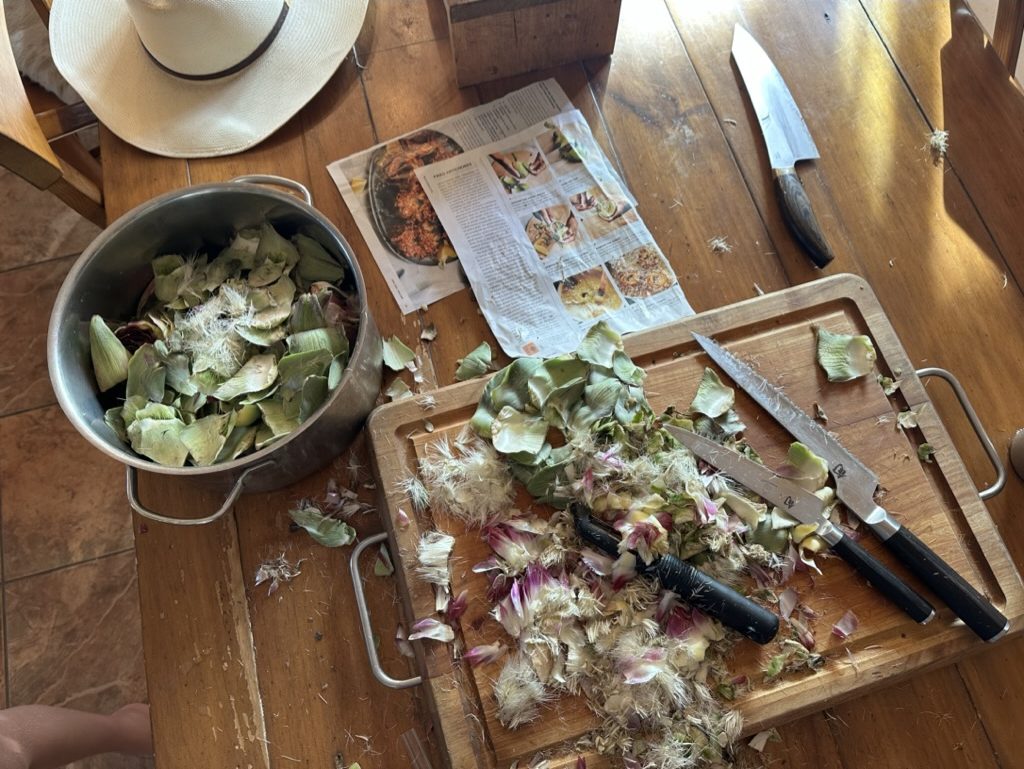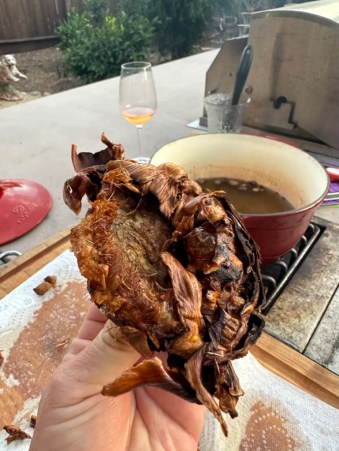Full Belly Files | Santa Cruz Mountains Meandering
This edition of Full Belly Files was originally emailed to subscribers on August 4, 2023. To receive Matt Kettmann’s food newsletter in your inbox each Friday, sign up at independent.com/newsletters.

Sunset overlooking Ano Nuevo and Ben Lomond north of Santa Cruz | Credit: Matt Kettmann
As I usually do around the time of the golf tournament that we put on in Santa Cruz every summer in memory of my father, I spent some time checking in with winemakers around the Santa Cruz Mountains a couple weeks back. Over two days, I met with winemakers, and one cider maker, from Aromas up to Ben Lomond, learning about the latest in this historic and huge, yet very much energized and focused, wine country.
Highlights included:


Ryan Stirm’s redwood tanks (left) and a Riesling by Stirm Wines | Credit: Matt Kettmann
- Sipping on riesling, white blends, and canned spritz cocktails with Ryan Stirm of Stirm Wine Co. in Aromas near where 101 cuts through Prunedale. The Concord-raised, Cal Poly–educated winemaker, who cut his chops working with Tyler Winery here in Santa Barbara County, just planted a small vineyard of vermentino, albariño, and furmint near the banks of the Pajaro River. He ferments his wine in old-school redwood tanks, which is just super cool and rare.
- Meeting Anthony Copriviza of Pelayo Cider, who’s using the apple orchard that his Croatian great-grandfather planted in Watsonville a century ago to make still cider in the Spanish Basque tradition. Even though we’d just met, he agreed to fill a slot that opened at the last minute for my dad’s tourney, and brought a friend who happened to know my cousins. He’s well aware that teaching Americans about still, slightly funky cider might be an uphill battle, but he’s proud to be spreading that culture around the region — and selling out his cans and bottles from retailers rather quickly.


Anthony Copriviza pours Pelayo Cider in the Basque style (left) and Florez Wines | Credit: Matt Kettmann
- Seeing the newish winery for Florèz Wines, where winemaker James Jelks showed me around and tasted me on some of his proudly natty bottlings. He attended UCSB for a couple of years to study aquatic biology until a love of wine lured him back home to Davis. He shares his winery with Megan Bell of Margins Wine, but she was on a rare vacation.

- Tasting with Ryan Alfaro, the second-generation winemaker of Alfaro Family Wines, a longtime leader in exploring the ocean-influenced terroirs of Corralitos and Aptos, as well as the proprietor of his own label, Farm Cottage. Ryan was on the way down south to go to the wedding of Nick Perr, whose family owns Pali Wine Co. here in Santa Barbara County.


Keegan Mayo of Assiduous Wines (left) and the “Power Piedmonte” by Regan Vineyards Winery | Credit: Matt Kettmann
- Visiting in Soquel with Keegan Mayo, winemaker for Bargetto Winery, where the history goes back a century, and his own Assiduous Wines. John Regan came to say hi and share a new wine from his newer brand, Regan Vineyards Winery. It was a nebbiolo boosted with cabernet sauvignon that he was calling “Super Piedmonte,” à la the “Super Tuscan” model. I suggested “Power Piedmonte” instead. We’ll see if they go for it….
- Sandar & Hem is one of the most exciting labels I’ve tried in recent years, so I met proprietors Rob and Recha Bergstrom at the Le Boeuf Vineyard, where legendary UC Santa Cruz elephant seal expert Burney Le Boeuf planted vines in 1974. Burney was there too, and he’s not missing any beats even though he’s in his eighties. The conversation about old-school sites getting new-school attention was inspiring.


Sandar & Hem’s Rob Bergstrom (left) and Burney Le Bouef, plus the Ben Lomond view over Ano Nuevo | Credit: Matt Kettmann
- Rob headed with me further up the hills to see our mutual friend Ryan Bearuregard of Beauregard Vineyards, who took us, along with my cousin, to an under-construction storage-container home owned by friends in the energy beverage business overlooking Año Nuevo. We sipped on some 1970s gems that Rob brought, and talked about UFO sightings at the nearby Lockheed Martin facility.
Never Again Dept.: Roman-Jewish Artichokes

On the way back from Santa Cruz — a trip that also involved me losing my cell phone on a roller coaster at Great America, the Santa Clara amusement park that I frequented steadily as a kid — I stopped at my favorite produce stand in Moss Landing. The point was to buy artichokes — I got 10 for $2, plus a bigger set of three for $9 — so that I could finally make the Roman-Jewish artichoke recipe that showed up in Food & Wine magazine a few months back.
I did so last Sunday after a long day at Campus Point, and found the experience to be excruciatingly laborious, slightly painful, and rather hand-staining. At least now I know why the artichoke-based liqueur Cynar is black as night. My fingernails and thumbs are still stained a rotten shade of brownish green as I type this.


The Roman-Jewish fried artichoke experience, including stained choke fingers | Credit: Matt Kettmann
After cutting, peeling, and pitting the chokes, I had to fry them twice. The results were pretty good, though still a bit fibrous and nothing like the ones I was blown away by in Rome two decades ago. A learning experience, and one I will never do again.

From Our Table

I skipped a week while traveling, so there’s a lot to catch up on, and it’s not all food and wine:
- The Lark turns 10 years old this year, so I interviewed Chef Jason Paluska about his tenure through that entire period.
- Mostly out of personal curiosity, I checked into what was happening with Hidden Oaks Golf Course near More Mesa. This is what I learned.
- I wrote about the sale of Buttonwood Farm & Winery to a hospitality/sustainable ag/development group. The story announces plans to build 60 cottages, though they tried to get me to take that out of the story after it was published; suffice to say, it’s a work in progress. But it’s causing a lot of buzz in the Santa Ynez Valley.
- The Independent launched a brand-new online franchise this past week called Indy Parenting. I wrote this story about how I am not Santa Barbara’s Ted Lasso, a funny, hopefully charming memory of coaching my son’s soccer team when they were in kindergarten.
- Rebecca Horrigan wrote about a hot new mobile business called Welcome Coffee Cart.
- And intern Colette Victorino does what I have done the past few years by covering the Greek Orthodox Church’s annual Gyro Grab & Go event.




You must be logged in to post a comment.